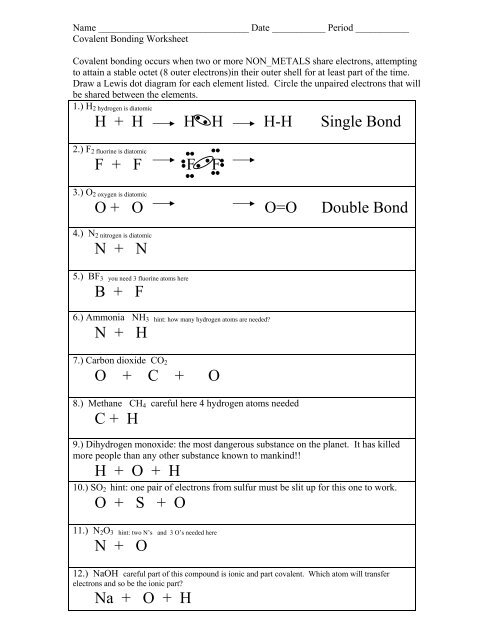Chemical bonds are the forces that hold atoms together in a compound. There are three main types of chemical bonds: ionic, covalent, and metallic. Understanding these different types of bonds is essential in understanding the properties of different substances.
On an ionic bond worksheet, students are typically asked to identify and describe compounds formed by the transfer of electrons between atoms. Ionic bonds are formed between a metal and a nonmetal, where the metal atom loses electrons to become a positively charged ion, and the nonmetal gains those electrons to become a negatively charged ion. Students may be asked to draw Lewis structures, identify the ions involved, and calculate the charges of the ions.
Covalent bond worksheets focus on compounds formed by the sharing of electrons between atoms. In covalent bonds, atoms share electrons in order to achieve a full outer shell of electrons. These worksheets may ask students to draw Lewis structures, determine the number of shared electrons, and predict the shape of the molecule based on the arrangement of atoms and lone pairs.
Metallic bond worksheets introduce students to the unique bond found in metals, where electrons are delocalized and move freely throughout the metal structure. This gives metals their ability to conduct electricity and heat. Students may be asked to explain why metals are malleable and ductile, as well as draw diagrams showing the electron sea model of metallic bonding.
Overall, understanding the different types of chemical bonds is crucial in understanding the properties and behaviors of different substances. By completing worksheets on ionic, covalent, and metallic bonds, students can develop a deeper understanding of how atoms interact to form compounds and why substances exhibit certain characteristics. These worksheets can also help reinforce important concepts and improve problem-solving skills in chemistry.
In conclusion, types of chemical bonds worksheets provide valuable practice for students to reinforce their understanding of ionic, covalent, and metallic bonds. By completing these worksheets, students can enhance their knowledge of chemical bonding and its role in determining the properties of substances. Teachers can use these worksheets as a tool to assess student understanding and provide targeted feedback to help students improve their comprehension of chemical bonds.
